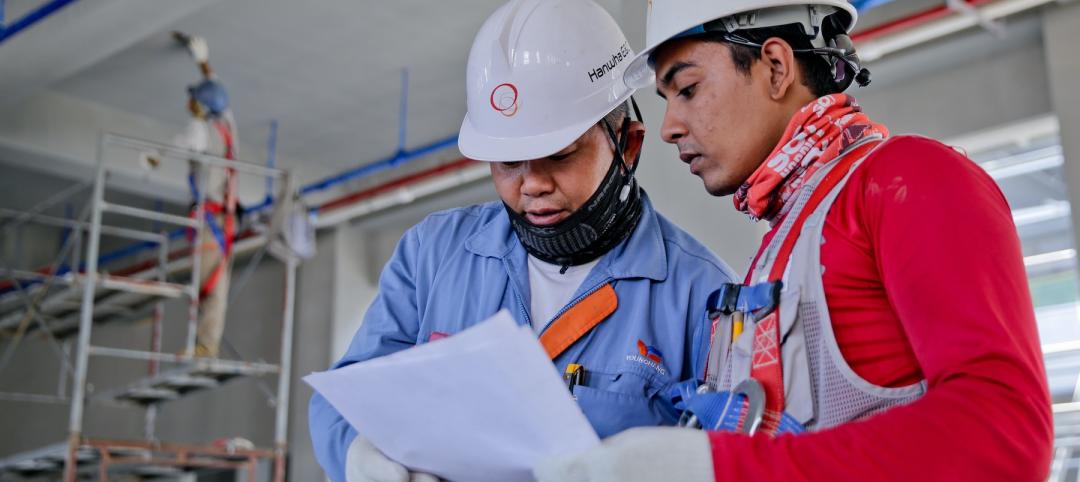Since April, Arup, the global built environment consultant, has been gathering data on an undisclosed number of buildings it has worked as a prelude to its commitment, which commenced this month, to conduct whole lifecycle carbon assessments for all of its construction and renovation projects going forward.
Those assessments will attempt to estimate a building’s carbon emissions from pre- and post construction, and encompass such variables as manufacturing, transportation, materials selection, operations, and maintenance. Arup estimates that as much as half of a building’s lifecycle CO2 emissions is attributable to embodied carbon before the building is operational.
Arup’s goal through its commitment is to confidently advise its developer-owner clients, within budgetary and quality parameters, on what products for each of a building’s systems and subsystems will produce the least amount of carbon emissions during a building’s duration. “We’re attempting to build our insights so that CO2 becomes a performance metric,” explains Erin McConahey, PE, FASHRAE, Principal and Arup Fellow. What’s been lacking—and what Arup is trying to address with its assessments—has been a critical mass of data.
ASSESSMENTS REQUIRED MORE DATA
When it announced its commitment last November, Arup stated that fewer than 1 percent of building projects was evaluated to quantify carbon emissions over their lifecycles.
Adopting whole lifecycle carbon assessments is essential to Arup’s and the building sector’s shared ambition to reduce projects’ carbon emissions 50 percent by 2030. The insights gained from conducting thousands of whole lifecycle carbon assessments each year “will help the built environment sector advance toward net zero,” stated the firm, which is developing similar methodology to extend its assessments to its infrastructure work.
Using a digital platform it devised, hundreds of project teams at Arup have been collecting carbon data on several of its 1,300 projects that met certain dollar thresholds of activity within the last fiscal year, and on whose design Arup was directly involved, says McConahey. That platform leverages materials information from measuring tools such as the Embodied Carbon in Construction Calculator (EC3), whose database allows users to compare materials for their embodied carbon impact; and Environmental Product Declarations (EPDs), through which manufacturers present objective, third-party verified data to report on the impact of their products and services.
McConahey says that, at present, manufacturers “are the only source of truth” when it comes to lifecycle carbon assessments of their own products. She adds that more contractors are asking for EPDs as part of their bidding and estimating.
DESIGNING FOR CARBON REDUCTION
The data that Arup has been assembling will allow the firm to review and adjust its design practices “using carbon rules of thumb,” says McConahey. Early next year, Arup intends to share some of its top-line insights with the industry, with an aspiration of providing a blueprint for the built environment’s path toward net zero.
Arup’s commitment is part of an ever-growing focus on environmental, social, and governance topics and reporting for construction and engineering firms. “Health, safety and labor; contracts and competitive bidding; and carbon emissions from buildings and construction form the backbone of their ESG agendas,” wrote the accounting and management consultant EY in a paper it posted last November about the state of ESG in the engineering and construction industry.
That paper found that among the 24 engineering and construction companies reviewed, leaders were making disclosures against at least 20 of 24 metrics covering ESG issues. This level of transparency is being driven by investors that evaluate ESG performance on corporate disclosures; and by Millennial workers who are three times more likely to seek employment with a company because of its stances on environmental and/or social issues.
Related Stories
| Aug 15, 2022
Boston high-rise will be largest Passive House office building in the world
Winthrop Center, a new 691-foot tall, mixed-use tower in Boston was recently honored with the Passive House Trailblazer award.
Hotel Facilities | Aug 12, 2022
Denver builds the nation’s first carbon-positive hotel
Touted as the nation’s first carbon-positive hotel, Populus recently broke ground in downtown Denver.
Energy Efficiency | Aug 11, 2022
Commercial Energy Efficiency: Finally “In-the-Money!”
By now, many business leaders are out in front of policymakers on prioritizing the energy transition.
| Aug 8, 2022
Mass timber and net zero design for higher education and lab buildings
When sourced from sustainably managed forests, the use of wood as a replacement for concrete and steel on larger scale construction projects has myriad economic and environmental benefits that have been thoroughly outlined in everything from academic journals to the pages of Newsweek.
Legislation | Aug 5, 2022
D.C. City Council moves to require net-zero construction by 2026
The Washington, D.C. City Council unanimously passed legislation that would require all new buildings and substantial renovations in D.C. to be net-zero construction by 2026.
Sponsored | | Aug 4, 2022
Brighter vistas: Next-gen tools drive sustainability toward net zero line
New technologies, innovations, and tools are opening doors for building teams interested in better and more socially responsible design.
Sustainability | Aug 4, 2022
To reduce disease and fight climate change, design buildings that breathe
Healthy air quality in buildings improves cognitive function and combats the spread of disease, but its implications for carbon reduction are perhaps the most important benefit.
K-12 Schools | Aug 1, 2022
Achieving a net-zero K-12 facility is a team effort
Designing a net-zero energy building is always a challenge, but renovating an existing school and applying for grants to make the project happen is another challenge entirely.
Codes and Standards | Jul 29, 2022
Few projects and properties are being built beyond code
Clients and architects disagree on how well building to code provides resilience, according to a recent report by the American Institute of Architects (AIA) in partnership with Owens Corning.
Multifamily Housing | Jul 26, 2022
All-electric buildings – great! But where's all that energy going to be stored?
There's a call for all-electric buildings, but can we generate and store enough electricity to meet that need?

















